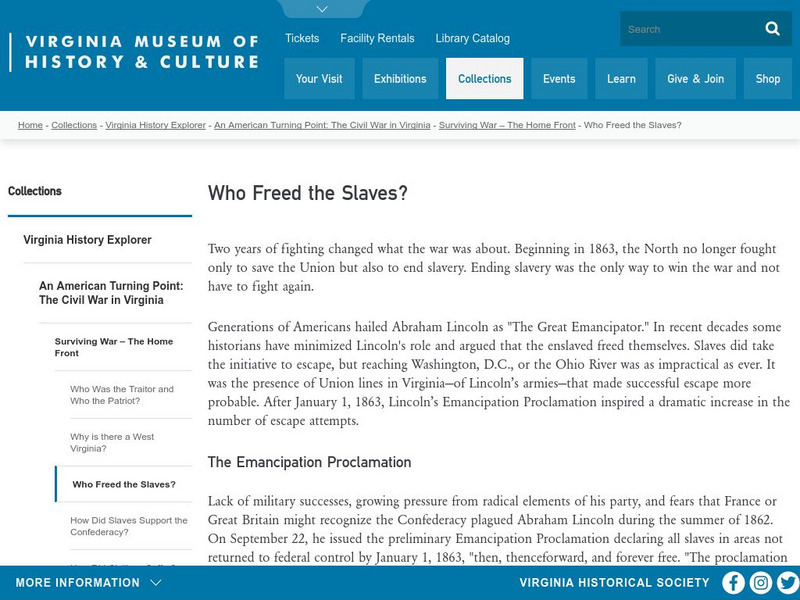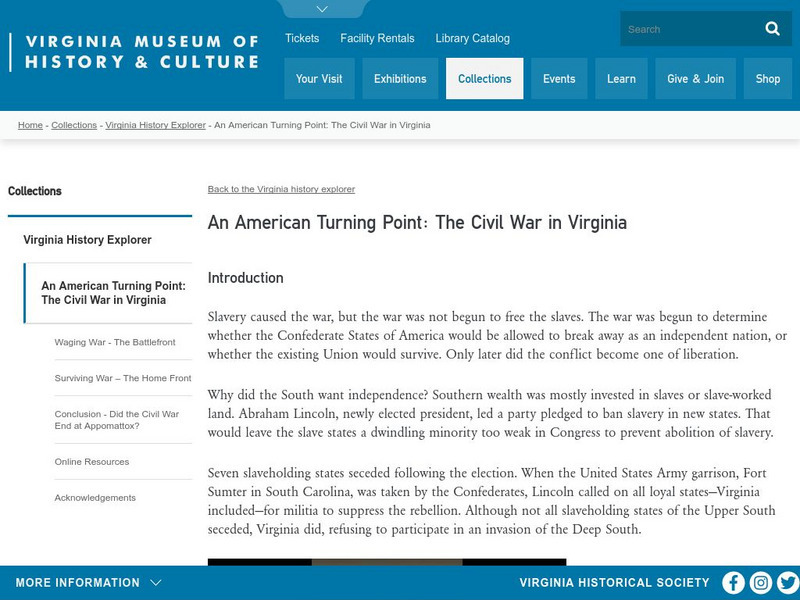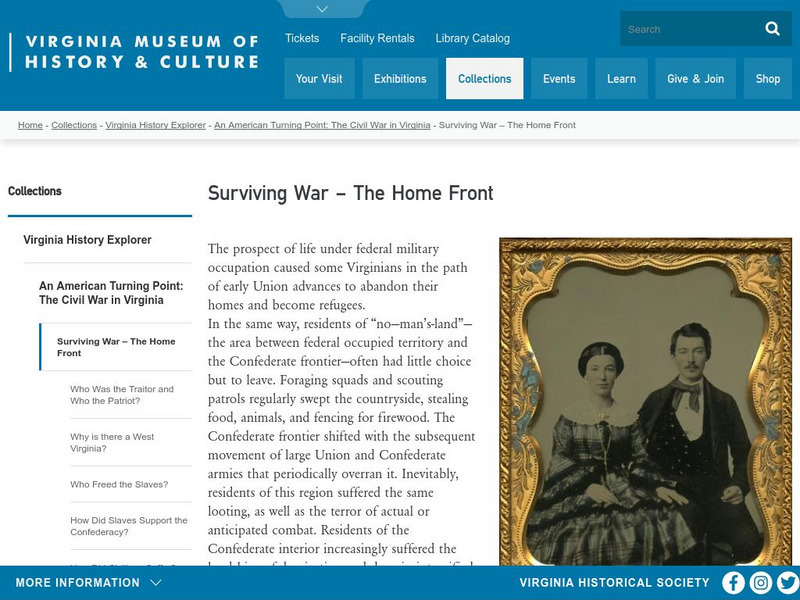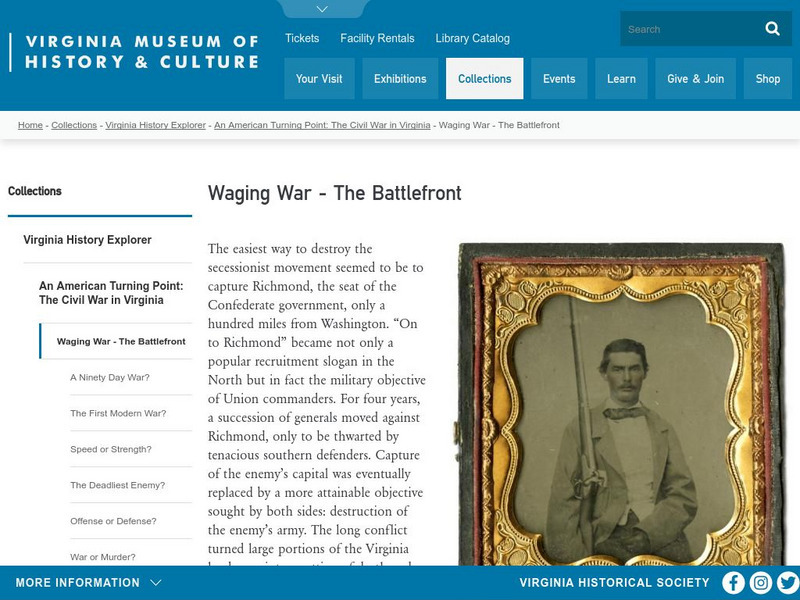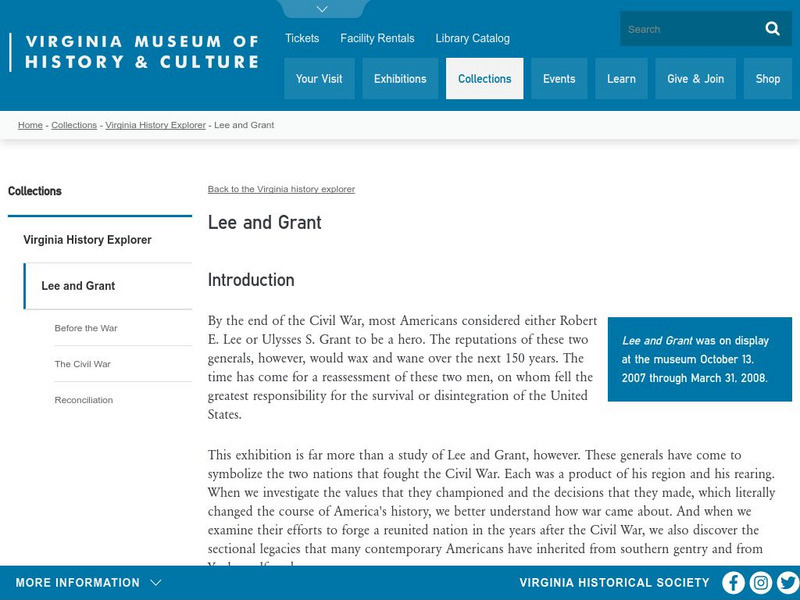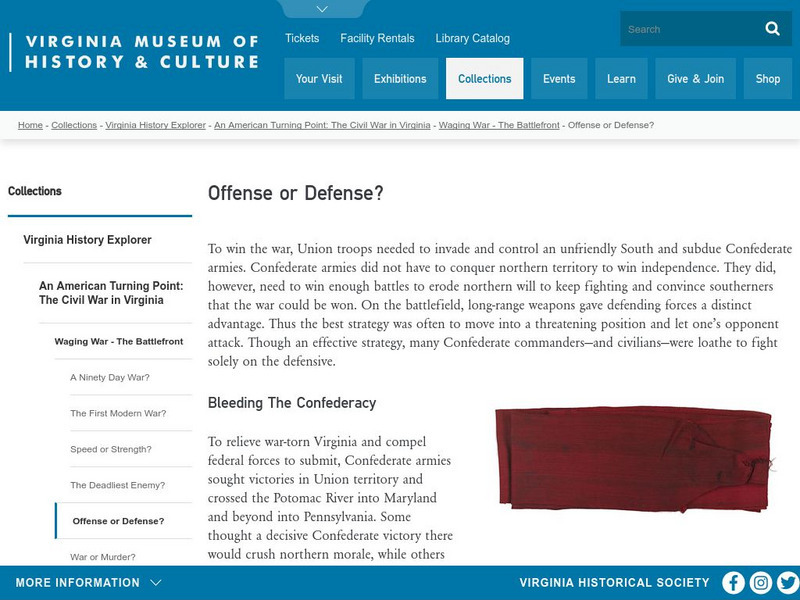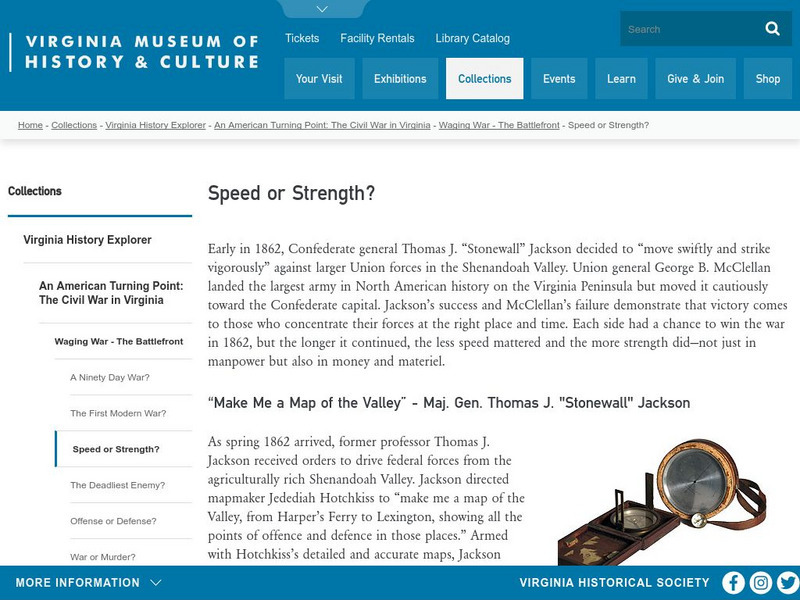Virginia Historical Society
Virginia Historical Society: The Portent: John Brown's Raid in American Memory
Online companion of an exhibition mounted in 2009 to commemorate the anniversary of John Brown's raid on Harpers Ferry examines Brown's role as a catalyst of the American Civil War.
Virginia Historical Society
Virginia Historical Society: The Home Front: Who Freed the Slaves?
Describes how the Emancipation Proclamation of 1863 came into existence, the response from the South, and the impact it had. Three works of art from that period are presented, and the imagery and symbolism explained.
Virginia Historical Society
Virginia Historical Society: Home Front: How Did Slaves Support the Confederacy?
Read about the different roles that slaves and freed blacks took on in Virginia during the Civil War. They provided labor while the white men were away fighting and they helped with the military efforts. Many took the opportunity to...
Virginia Historical Society
Virginia Historical Society: Why Is There a West Virginia?
A short discussion of how Virginia became divided into two states. Presents a map of the counties from the census of 1860 that shows the distribution of slave ownership.
Virginia Historical Society
Virginia Historical Society: Massive Resistance
A chilling account of the ways Virginia lawmakers attempted to subvert the Supreme Court decision in Brown v Board of Education in 1958. Read about the Southern Manifesto, and the group of laws known as Massive Resistance.
Virginia Historical Society
Virginia Historical Society: An American Turning Point: Civil War in Virginia
An exhibition that commemorated the 150th anniversary of the American Civil War. While slavery caused the war, the war was not begun to free the slaves, but to determine whether the Confederate States of America would be allowed to break...
Virginia Historical Society
Virginia Historical Society: Conclusion: Did the Civil War End at Appomattox?
While the American Civil War officially ended at the Battle of Appomattox, Confederate sensibilities ran deep and it was not until the Civil Rights Movement in the 1950s and 1960s that blacks were able to fully assert their equality....
Virginia Historical Society
Virginia Historical Society: Surviving War: The Home Front
An online exhibition that looks at what life was like for Virginians under military occupation. Many of them became refugees rather than stay while Union troops invaded their lands, stealing crops, burning fields, and taking over homes.
Virginia Historical Society
Virginia Historical Society: Waging War: The Battlefront
An online exhibition that looks at how the Civil War was fought in Virginia, as the Union tried to reach and capture Richmond, which was the seat of the Confederate government.
Virginia Historical Society
Virginia Historical Society: The Home Front: How Did Civilians Suffer?
Describes the many hardships that citizens, no matter what their status, faced in Virginia during the Civil War. One town, Winchester, switched hands about seventy-two times during the war. Many people lost loved ones, as well as their...
Virginia Historical Society
Virginia Historical Society: Surviving War: The Home Front: Why Richmond?
Why was Richmond made the Confederate capital and how did that status change life there? Learn the reasons for this decision and the widespread impact it had on the city.
Virginia Historical Society
Virginia Museum of History and Culture: Teaching With Photographs
"Teaching with Photographs" includes images from the Virginia Historical Society's collection. The images are organized into several themes which allows this source to be used by younger and older grades. Resources for teachers are...
Virginia Historical Society
Virginia Historical Society: Heads & Tales
As part of the extensive VHS library, this section presents the portraits and biographies of five compelling individuals. As described on the site, 'their tales are told by analysis of components of their pictorially complex portraits'.
Virginia Historical Society
Virginia Historical Society: Waging War: The Battlefront: The First Modern War?
Discusses some of the new military and other technologies that were used during the Civil War in Virginia.
Virginia Historical Society
Virginia Museum of History and Culture: Early Images of Virginia Indians
A collection of images of early Virginia Indians that includes information on interpreting the images and shows fanciful images that were not historically accurate.
Virginia Historical Society
Virginia Historical Society: Lee and Grant
A retrospective of the two greatest generals of the Civil War, Robert E. Lee and Ulysses S. Grant. A side-by-side comparison of the two icons before, during, and after the war.
Virginia Historical Society
Virginia Historical Society: Waging War: The Battlefront: Men of Color to Arms?
When the war began, many African Americans - North and South - volunteered to serve as soldiers. The vast majority were former slaves who sought to strike at slavery and improve their position in society. Desperate to avert defeat, the...
Virginia Historical Society
Virginia Historical Society: Waging War: The Battlefront: The Deadliest Enemy?
Discusses how bacteria and viruses killed many more Civil War soldiers than wounds from weaponry. Presents some of the medical instruments used by military doctors, and an artificial leg invented by the first amputee of the war, James E....
Virginia Historical Society
Virginia Historical Society: Waging War: The Battlefront: Offense or Defense?
To win the war, Union troops needed to invade and control an unfriendly South and subdue Confederate armies. Confederate armies did not have to conquer northern territory to win independence. They did, however, need to win enough battles...
Virginia Historical Society
Virginia Historical Society: Waging War: The Battlefront: Speed or Strength?
Confederate General Jackson's success when he moved swiftly in the Shenandoah Valley in early 1862, and Union General McClellan's failure when he moved cautiously towards Richmond, demonstrate that victory comes to those who concentrate...



